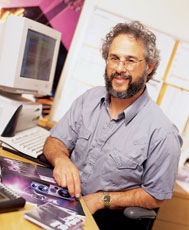|
|
What? A Card? |
October 2001 |
|
Few observers doubt that the advent of high-speed, dual-processor Power Macs and PCs is a significant boon for desktop-based music producers. Obviously, the arrival of still faster G4s and Pentiums or compatible CPU chips is only a matter of time. Unix-based, multi-threaded operating systems such as Windows 2000, Linux, and Mac OS X are rapidly becoming practical for desktop musicians (see ĺ─˙Desktop Musician: Mac OS X for Musiciansĺ─¨ on p. 100).
Until recently, DSP cards were the answer to limited CPU power, especially in the absence of multi-threaded operating systems. Dedicated cards take a big load off the CPU, and some specialized DSP chips can do certain types of computation more efficiently than a general-purpose CPU.
Some people argue that inherently multiprocessor-capable operating systems and ever-increasing CPU speeds spell the end for dedicated DSP cards for audio applications. From the software side, it's simpler to write code for one or two standard CPU chips than to write for multiple products that use mutually incompatible DSP chips, drivers, or operating systems. Furthermore, writing code for the Motorola 56000 ĺ─ţ series DSP chips used in many DSP cards is a specialized skill that a lot of excellent programmers lack. And the fact that you cannot run, say, a Mixtreme plug-in on a Pulsar card reduces the end user's choices, especially when using plug-ins in multiple environments. Native processing has none of those limitations.
Furthermore, CPUs for desktop computers are mass-market items and are relatively inexpensive; currently, dedicated DSP cards for audio are specialty items and are usually more costly ĺ─ţ in some cases, much more costly. Of course, that could change if some unforeseen consumer application were to drive the market for more-powerful audio cards, as the game market has done for video accelerators. But so far, consumer audio cards are relatively low-powered products.
On the other hand, if you want to run several heavy-duty reverb plug-ins and a few other effects at the same time, you can quickly put a hurt on your CPU, even if it is capable of supercomputer-level speeds. A DSP card guarantees a minimum amount of available computing power and allows your main CPU to run the basic OS and app. Go ahead and run that heavy-duty reverb. Heck, run three. You probably will still have DSP to burn on the more-powerful cards, and your main CPU won't feel at all pressured.
Another argument for DSP cards is that software written for a specific card as a closed system could theoretically mean a more efficient and stable system ĺ─ţ whether that is consistently the case in practice is an open question. It makes sense that a company could write better software for its own custom hardware than it could for native processors. Writing for someone else's hardware could be another story.
The jury is still out, but it appears that native software is gaining ground, even if we agree that dedicated DSP cards provide superior specialized processing power. It will be interesting to see how manufacturers of such products respond. |
